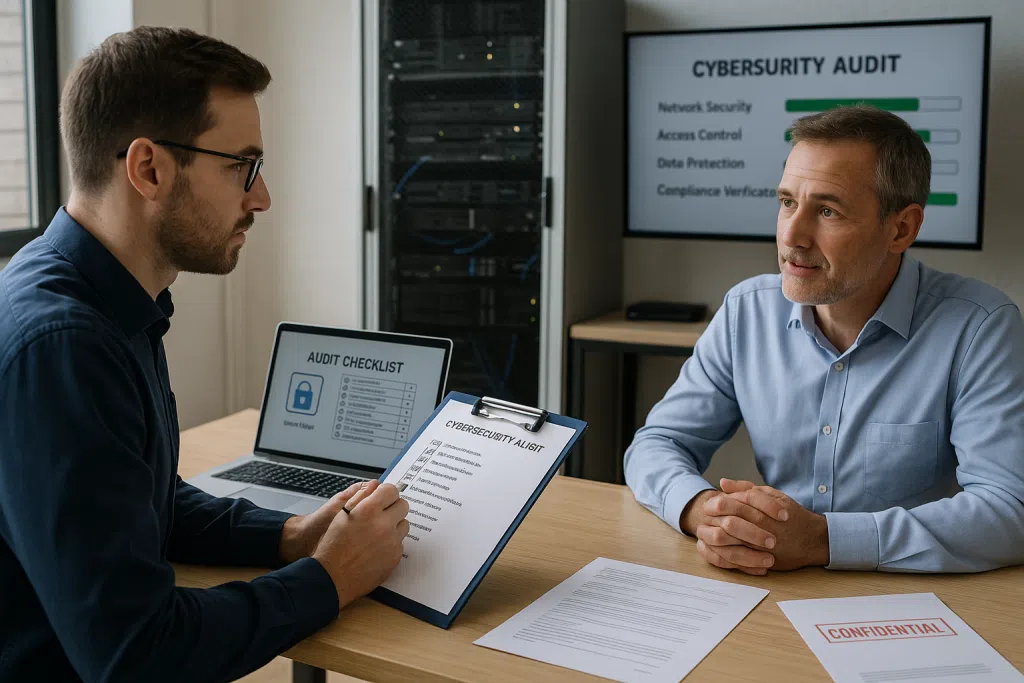Security in the digital landscape is no longer just an IT issue, it’s a pivotal concern for every small and medium business (SMB) in regulated industries like healthcare, finance, law, and pharmaceutical sectors. As ransomware attacks grow in complexity and compliance requirements tighten across state and federal levels, adopting and following a detailed cyber security audit checklist is critical for safeguarding data and maintaining the trust of clients, regulators, and business partners. Whether you’re part of an in-house IT team, managing compliance for a busy law firm, or overseeing sensitive healthcare data, understanding every item on a security checklist is the foundation for operational resilience, and regulatory peace of mind.
For companies that want to stay ahead of evolving threats and ever-changing rules, the right approach isn’t about one-off assessments. Instead, it’s about integrating a living, thorough cybersecurity compliance strategy, one that helps you achieve and maintain a strong security posture while preparing for audit scrutiny and regulatory reviews. In this guide, you’ll find a pragmatic, detailed, and actionable cyber security audit checklist built specifically for regulated SMBs, paired with real-world best practices and vital data for today’s threat landscape.
If you’re ready to strengthen your risk management foundation and pass your next compliance assessment with confidence, book an initial Discovery meeting to map your unique risks and requirements with Blueclone Networks.
Building the Foundation: Why Every SMB Needs a Cyber Security Audit Checklist
Every SMB handling confidential information, whether it’s patient health records, financial data, or legal contracts, is a prime target for cyberattacks. According to Verizon’s 2025 Data Breach Investigations Report, over 61% of breaches hit businesses with fewer than 1,000 employees. This statistic alone underlines just how crucial structured cybersecurity audits are, especially as attackers use sophisticated social engineering and leverage gaps in manual or outdated systems.
But not all checklists are created equal. In regulated industries (healthcare, finance, legal, pharmaceuticals), your audit must account for more than just technology. It needs to align with industry regulations like HIPAA, PCI-DSS, FINRA, and increasingly, CMMC or NIST frameworks if you work with government supply chains or public agencies. Failure to accurately document, implement, and track actions on a regulatory compliance checklist could result in severe penalties, operational downtime, or loss of accreditation.
What’s Included in a Comprehensive Data Security Checklist?
A robust cybersecurity audit checklist focuses on several core areas:
- Asset Inventory and Classification: Identifying every device, server, cloud account, and endpoint where sensitive data resides.
- Access Controls and Identity Management: Reviewing how users are authenticated, and what data or system rights they hold.
- Data Encryption and Backup: Ensuring data is encrypted both in motion and at rest, and confirming backup processes are securely configured and restorable.
- Vulnerability Management: Regular patching, ongoing vulnerability scanning, and remediation of system weaknesses.
- Incident Response Planning: Documented processes for identifying and addressing breaches, along with regular response drills.
- Vendor Risk Management: Verifying that third-party providers (cloud, SaaS, managed service partners) follow your security standards.
Why a Checklist is More Than a Box-Ticking Exercise
The reality is, using a cybersecurity compliance checklist shouldn’t be a static “set-it-and-forget-it” activity. Cyber threats, tech stacks, and regulations change rapidly. Checklists should be dynamic, updated with lessons learned from threat intelligence feeds, new internal processes, and changes in the law. For instance, the New Jersey Department of Banking and Insurance recently issued updated guidelines for covered entities, including specific controls around Multi-Factor Authentication (MFA) and incident reporting that SMBs must adhere to.
Reviewing and refining your checklist every quarter, or in response to major IT changes, ensures you’re not just audit-ready, but genuinely protected. Regular self-assessments let you proactively detect configuration errors, user mistakes, or new risks before auditors (or attackers) do.
Ready to transform your generic list into a living governance tool that stands up to boardroom scrutiny and regulatory review? Book an initial Discovery meeting and get tailored guidance from cybersecurity leaders.
Core Elements of an Effective Cyber Security Audit Checklist
A well-designed checklist is the backbone of audit readiness and ongoing protection. Let’s break down the essential components every SMB should include, regardless of industry or size.
1. Data Mapping and Asset Inventory
You can’t secure what you don’t know you have. Begin by cataloging all endpoints, servers, SaaS applications, and cloud storage repositories where sensitive or regulated information flows. This “inventory first” mindset is fundamental not only for HIPAA or PCI-DSS compliance, but also for emerging state privacy standards in New Jersey, New York, and Pennsylvania.
Why is this important?
If your team misses even one cloud database or remote device, you create a potential attack target. In a recent Healthcare IT News report, nearly 50% of ransomware attacks in the sector originated from overlooked or misconfigured cloud services.
Checklist Items:
- Document all business devices, including laptops, mobile phones, printers, and IoT devices.
- List every location where data is stored: on-premises servers, cloud drives (e.g., Microsoft 365, Google Workspace), SaaS platforms, and backups.
- Classify data based on sensitivity, HIPAA-protected health information (PHI), client financial data, and legal documents, for risk prioritization.
Tip:
Automate this process where possible using endpoint management or asset discovery tools. Pair the process with annual or quarterly reviews, especially when onboarding or terminating users or deploying new applications.
2. Access Management and Authentication Policies
Human error remains one of the top causes behind data breaches and compliance failures. Outdated credentials, inactive accounts, or shared passwords can offer a backdoor for attackers or rogue employees.
Checklist Items:
- Enforce strong password policies, including minimum complexity standards and expiration intervals.
- Audit user accounts often, disable or delete those unused or belong to former staff.
- Deploy Multi-Factor Authentication (MFA) on all business-critical systems, from your email to financial portals.
- Segregate duties and define user roles, ensuring individuals only access what they need for their job (“least privilege” principle).
3. Network Security and Vulnerability Management
Networks are the digital highways of your business, but unpatched vulnerabilities act like potholes waiting for threat actors. SMBs must scan, identify, and address vulnerabilities before they become costly breaches.
Checklist Items:
- Install stateful firewalls and ensure rules are reviewed regularly.
- Implement intrusion detection and prevention systems (IDS/IPS).
- Schedule automated vulnerability scans and apply device/server patches in line with manufacturer or regulatory guidance.
- Encrypt data in transit using secure protocols such as TLS 1.2+.
4. Data Security Checklist: Encryption, Backups, and Recovery
Protecting data extends beyond just storage; it’s about ensuring information is unusable if lost or stolen and can be recovered without data loss.
Checklist Items:
- Use end-to-end encryption for sensitive data at rest and during transfer.
- Regularly test backups, run drills to restore from backups, and confirm data integrity.
- Follow a 3-2-1 backup strategy (three copies, two media types, one offsite).
- Document and test disaster recovery plans for all critical systems.
5. Security Awareness and Training
No technology compensates for untrained or careless staff. Social engineering remains a favored attack vector, as employees inadvertently click malicious links or share sensitive information.
Checklist Items:
- Conduct mandatory security training for all employees, covering phishing, password policies, and data handling.
- Run periodic tests, such as simulated phishing campaigns, to gauge and improve employee vigilance.
- Require documented “clean desk” policies and enforce data shredding/disposal protocols.
- Track training completion and incorporate it as a performance metric for managers.
6. Incident Response and Reporting
Being prepared for security events is as important as trying to prevent them. An incident response plan ensures that your team reacts swiftly, minimizes loss, and fulfills legal obligations.
Checklist Items:
- Develop and review written incident response procedures at least annually.
- Create response teams with clear roles and escalation paths.
- Define thresholds for notifying management, affected parties, and regulators based on the size and nature of incidents.
- Keep a log of all incidents, responses, and outcomes for post-mortem analysis and future training.
7. Regulatory Compliance Checklist Integration
For SMBs in regulated fields, the line between information security and compliance is paper-thin. Your cyber security audit checklist must thread in everything required under HIPAA, PCI-DSS, SOX, or other frameworks relevant to your sector.
Checklist Items:
- Align security policies and evidence collection to the specific requirements in each regulation.
- Maintain audit logs for all access and changes to sensitive data, with retention periods dictated by legal requirements.
- Review and update your compliance readiness cybersecurity guide with new law changes or best-practice guidelines from industry associations.
- Work with counsel or external experts to double-check interpretations of ambiguous regulations.
Midway through these critical steps, if you want tailored advice on policy mapping or managing complex regulatory gaps, schedule a conversation with a compliance-versed expert at Blueclone Networks: Book an initial Discovery meeting
Creating a Living Cybersecurity Compliance Checklist: Best Practices for Ongoing Success
A static checklist quickly becomes obsolete in real business settings. New staff join, cloud services evolve, and attackers constantly probe for new vulnerabilities. Here’s how to make your cybersecurity compliance checklist adapt with you, without becoming a burden.
Involve All Levels of Staff
Security isn’t just an IT function. Engaging management, HR, and department heads in your checklist reviews improves accuracy and creates investment throughout the organization. Staff closest to sensitive processes often know about shadow IT, overlooked legacy tools, or workflow gaps that should be addressed.
Automate Where Practical
While manual reviews are necessary for nuanced decisions, today’s compliance and security tools can automate large portions of your data security checklist. For example, endpoint management suites not only inventory devices but also provide real-time alerts for unpatched software or failed backups.
Schedule Quarterly Reviews
Industry leaders recommend reviewing and updating your checklist at least once per quarter, or immediately after major security events or changes in IT infrastructure. This cadence matches how regulated frameworks such as HIPAA, SOX, and PCI mandate ongoing safeguards over a yearly cycle.
Document Everything
Auditors rarely give credit for verbal assurances or undocumented efforts. Every action on your checklist, from firewall updates to staff training completions, should be time-stamped and verified. This documentation not only satisfies regulators but also creates organizational memory and continuity during staff turnover.
Integrate With Broader IT Governance
Treat the cybersecurity audit checklist as an input to IT planning, budgeting, and risk management. By mapping checklist outcomes to broader business goals, like new service launches or data privacy commitments, you ensure that security underpins every aspect of growth.
According to a recent CSO Online article from January 2025, organizations that matured their audit and governance processes saw up to a 45% reduction in audit findings and a measurable drop in incident-related downtime.
How to Prepare for Your Next Audit: Steps to Ensure Cybersecurity Compliance
Passing a regulatory or client security audit shouldn’t be a roll of the dice. Proactive preparation makes all the difference and can ward off costly business interruptions, negative headlines, and fines.
1. Pre-Audit Gap Assessment
About six months before your next scheduled audit, conduct an internal gap analysis using your cybersecurity compliance checklist. Compare written policies, technical controls, and documented evidence against the requirements in your target framework (HIPAA, PCI, SOX, etc). Pay special attention to frequently overlooked areas such as:
- Unpatched legacy systems
- Incomplete vendor risk assessments
- Gaps in audit logging/retention
- Outdated incident response contact lists
2. Evidence Collection and Organization
Start gathering records for each checklist item, training certificates, policy documents, backup logs, system inventories, and recent vulnerability scanning reports. Store these in a secure, shared location accessible only to your audit team.
- Use naming conventions and metadata to make searching for audit requests quick and accurate.
- For sensitive evidence (e.g., protected health data), mask or anonymize records where possible for privacy.
3. Tabletop Drills and Staff Readiness
Simulate the audit process by walking through common auditor questions and control checks. Hold mini “mock audits” with department heads or cross-functional teams. Use these exercises not just to catch missing evidence, but to ensure staff understand their roles and can answer compliance-related questions confidently.
4. Engage Third-Party Reviewers
For complex audits or when major gaps are identified, consider a readiness assessment from a third-party consultant experienced in your regulatory space. They can help validate your findings, clarify ambiguous requirements, and provide documentation templates that match auditor expectations.
A recent analysis from Dark Reading (February 2025) revealed that SMBs partnering with seasoned compliance consultants reduced audit cycle times by up to 30%, minimizing revenue and resource disruptions.
5. Post-Audit Follow-ups
Even the most prepared teams will receive some form of findings or recommendations. Establish clear accountability for remediating issues, document each fix, and update your checklist to make the control environment stronger for the next cycle.
Action beats perfection – auditors respect organizations that learn from findings and demonstrate real progress over time.
Common Mistakes and How to Overcome Them on Your Data Security Checklist
Even organizations with mature IT teams can make simple, costly mistakes when managing their cyber security audit checklist. Here’s how to avoid the most frequent pitfalls:
1. Ignoring Shadow IT
Staff sometimes use unauthorized apps or cloud services to get their jobs done quickly, especially if official tools are slow or unavailable. While convenient, shadow IT exposes sensitive data to unknown risks. Periodically scan for unsanctioned software, browser extensions, and file-sharing services.
2. Overreliance on Technology Alone
Firewalls, anti-virus software, and encryption tools are essential, but they can’t prevent careless data sharing or overlooked staff accounts. Remember that many breaches hinge on mistakes, not technology flaws. Human factors, social engineering, and process issues should be part of every review.
3. Underestimating Vendor Risk
Most SMBs leverage at least five third-party vendors for core IT functions, from cloud hosting to SaaS accounting platforms. Yet, a survey by the Ponemon Institute (2025) found that 63% of SMBs never reviewed their vendors’ security policies or compliance status. Ask vendors for their attestation reports and ensure contracts specify breach notification timelines, data handling, and security practices.
4. Failing to Review and Update Policies
Written policies quickly become outdated as laws evolve and new threats appear. Schedule annual reviews, involving both IT and legal for changes in the regulatory environment (e.g., new requirements introduced by the New Jersey Privacy Act or updates in federal healthcare mandates).
5. Treating the Checklist as a Standalone Exercise
The best cybersecurity and compliance outcomes come when the data security checklist is embedded into daily operations. Integrate checklist reviews with staff onboarding/offboarding, software updates, and executive reporting. This keeps security top of mind and reduces the likelihood of gaps going undetected until the next audit cycle.
Bridging these gaps and fostering a security-driven business culture requires focused leadership and external guidance when needed. Ready to start strengthening your program? Book an initial Discovery meeting to get tailored support.
Frequently Asked Questions About the Cyber Security Audit Checklist
A cyber security audit checklist helps SMBs systematically evaluate and document their existing security controls, policies, and procedures. The checklist ensures that all critical areas, such as data protection, user access, network security, and compliance with regulations, are addressed consistently. It’s indispensable for preparing for regulatory audits and for proactively identifying security gaps before they lead to incidents.
The ideal frequency depends on your risk environment and regulatory framework. As a baseline, update checklists at least every quarter and whenever there are significant changes in IT systems, laws, or known threats. In highly regulated sectors, schedule reviews to coincide with annual compliance training and policy updates.
While the checklist’s principles remain the same, small businesses often have more streamlined tech stacks and fewer resources. The focus should be on core controls, asset inventory, access management, data encryption, vulnerability scanning, incident response, and regular training. However, regulatory requirements are not scaled based on business size, so even SMBs need to meet the same standards as their larger counterparts.
If auditors find issues, the organization is usually given a defined window to address them through corrective actions and documentation. Repeated or severe non-compliance can lead to fines, loss of certifications, or in some cases, criminal penalties. Transparent communication and swift remediation are key to minimizing impact.
Yes. Many modern compliance and security tools automate checklist creation, evidence collection, and even daily compliance monitoring. Still, human judgment is crucial for contextual decisions, policy reviews, and managing exceptions. The best outcomes come from combining automation with regular staff training and management oversight.





